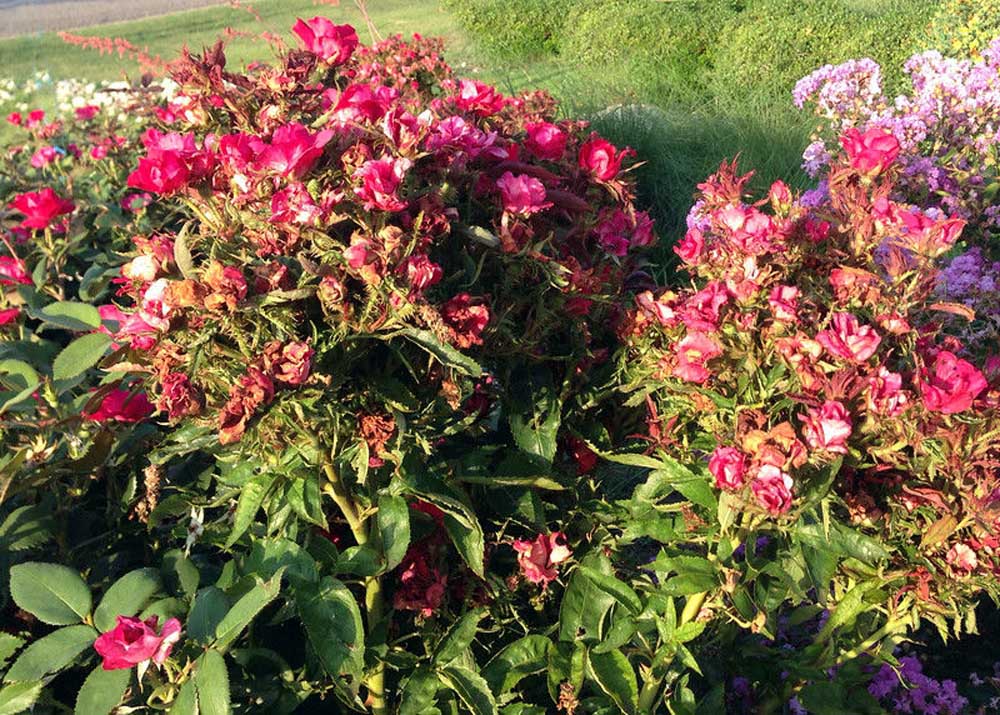GARDEN: Grant 12-29 RBG
Published 10:47 pm Wednesday, December 28, 2016

- NEAL SPERRY/COURTESY These rose bushes are showing the effects of rose rosette disease.
There’s a relatively new disease in town that is incurable and threatens our identity. Its name is rose rosette, sometimes referred to as “witches broom,” because of one of its distinguishing characteristics.
It was first found in Canada and Wyoming in the 1940s, and appeared in Texas in the 1990s. Though rose rosette has been documented in the both the Houston and San Antonio areas, it is by far most prevalent in the Dallas area, especially on the wildly popular Knock Out roses. I have seen lots of it in roadside and public plantings in the north Dallas and McKinney areas. It also occurs throughout the entire South.
Trending
The symptoms of this disease are quite distinct and shouldn’t be confused with anything other than broadleaf herbicide damage. The most noticeable sign is a deformed, dense clustered “witches broom” growth habit, with an abnormal bright red coloration. The plant basically goes crazy, as if it had been sprayed with 2,4-D herbicide. The stems might be flattened, enlarged or elongated, with excessive leaf growth or thorniness. Don’t confuse the burgundy-red, normal-shaped new growth of most China and tea roses as rose rosette. Also, be aware that the typical symptoms of rose rosette disease might only occur on a single or a few shoots at first, not the entire plant. The rose may die or may linger stunted for years, affecting other roses in the area.
So, what causes Tyler’s nightmare? Rose rosette disease is generally spread to other roses in two ways. In gardens and the wild, it is spread by a tiny eriophyid mite that feeds on an infected plant then spreads it to an uninfected plant that it later feeds on. These mites are so small that they can be spread by the wind. To be on the safe side, make sure roses are spaced so that they do not touch each other. Though pesky, the mite itself doesn’t cause the disease. It only spreads it. The other common way of spreading this deadly disease is through plant propagation. Any rose rooted from an infected plant will have the disease as well, as the virus is coursing through its sap and inner tissue. And any rose budded or grafted from an infected plant or onto an infected plant will have the disease, too.
Is there a cure for this dreadful disease? Unfortunately, there isn’t. Viruses are fairly common in the horticulture world – some deadly, some only slightly disfiguring and some hardly noticeable at all. But one common trait among them is there isn’t a cure for them in your garden, no matter what quack advice or miracle remedies you hear. I’ve been gardening all my life and have two degrees in horticulture. This is very common knowledge about viruses. Pruning out the noticeably infected branches won’t cure a bush, killing the mites on an infected plant won’t cure it either, and treating the plant or soil with assorted concoctions won’t cure this disease. By the time you see the symptoms, the disease is being replicated inside the plant with no way for you to rid it.
The only option you have is to completely remove and dispose of the entire plant, roots and all, when you know you have it, preferably at the very first sign of infection. If you allow an infected plant to live, you unfortunately are risking the life of all your other roses, along with everybody else’s. I don’t care how special the rose is or how much you paid for it. An infected plant, no matter how few branches seem infected, is a “Typhoid Mary” that can infect all other uninfected roses. If you remove infected plants but have others roses in the landscape, you would be wise to treat them with an appropriately labeled miticide to make sure they aren’t spreading it to your other plants. It is absolutely essential for cities, municipalities, businesses and botanical gardens to remove their infected plant, too.
Master Gardener groups, Master Naturalist groups, garden clubs, rose societies and other civic-minded organizations need to be diligent about scouting the landscape, along with providing sound education and advice on this horrible disease. Our rose gardening heritage depends on it.
I would also be very diligent in not only removing all infected roses, but also when propagating new plants or purchasing new plants. Rose plantings near naturalized stands of Japanese multiflora rose (Rosa multiflora) along with those in highly developed urban areas heavily planted with roses are most at risk.
Trending
If you suspect you have an infected rose, a sample can be sent to the Texas A&M Disease Diagnostic Laboratory. More information and submission forms can be found at http://plantclinic.tamu.edu. There is a $55 charge for testing rose rosette samples.
Greg Grant is the Smith County horticulturist for the Texas A&M AgriLife Extension Service. You can follow him on Facebook at Greg Grant Gardens, read his “Greg’s Ramblings” blog at arborgate.com or read his “In Greg’s Garden” in each issue of Texas Gardener magazine (texasgardener.com). More local information on the Texas A&M AgriLife Extension Service can be found at http://smith.agrilife.org.






